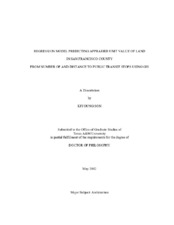| dc.description.abstract | The objective of this study is to develop a quantifying model that predicts the appraised unit value of parcels in San Francisco County based on number of LEED-NC Public Transportation Access (PTA) qualified bus, light rail and commuter rail stops, distance to closest bus, light rail and commuter rail stops, zoning class and parcel size. As a population of interest, San Francisco County was chosen since it is known as a region having well-organized transportation systems including bus, light rail and commuter rail systems.
According to the correlation results, for mixed zone, an appraised unit value increases as the number of LEED qualified transit stops increases (bus, light rail, and commuter rail). In addition, the appraised unit value increases as the distance to LEED qualified bus stops light rail stops decreases. For residential zone, the appraised unit value increases as the number of LEED qualified bus and light rail stations increases. Furthermore, the appraised unit value increases as the distance to LEED qualified bus stops decreases.
When it comes to the predictive regression model for mixed zone, the adjusted R-square of the transformed model was 0.713, which indicates that 71.3 percent variability in transformed unit value of parcels could be explained by these variables. In addition, for the predictive model of residential zone, the adjusted R-square for the model was 0.622 thus the independent variables together accounted for 62.2 percent variability in the transformed unit value of parcels.
The predicting models for mixed and residential zones were significant that suggests that the components of LEED-NC PTA criteria, number and distance from parcels, this could affect land development strategies. In addition, an appraised unit value of parcels in San Francisco County can be estimated by using the predictive models developed in this study. Therefore, the findings of this study could encourage real-estate developers to site their projects according to the LEED-NC PTA criteria. | en |


